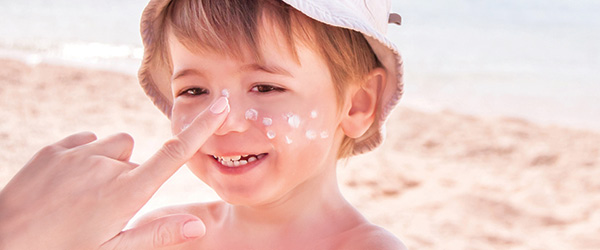Make Sun Safety for the Family a High Priority This Summer

 Children will be out of school soon and families will hopefully want to head to the beach, pool and participate in outdoor family adventures. Summer is a time to relax and enjoy friends and family.
Children will be out of school soon and families will hopefully want to head to the beach, pool and participate in outdoor family adventures. Summer is a time to relax and enjoy friends and family.
While summer is a time to be outdoors in the beautiful sunshine, it is also a time when children are susceptible to sunburn. A sunburn in a child especially an infant can lead to skin cancers like melanoma. Less sun, sun protective clothing and sunscreen are a wise investment in our children's future health.
Sunburns do not only occur at the beach but can happen while being outdoors anywhere especially with midday sun exposure. During the summer the sun’s ultraviolet rays are damaging for many hours even if it is cloudy.
Parents need to make sun protection part of the child’s daily routine like brushing teeth. Sunscreen should be applied hairline to toes before stepping out of the house in the morning. Hats and sunglasses should be adorned whenever outside. Sun protective daywear and swim wear should be in every child's wardrobe.
Sunscreen works best when it is applied 30 minutes prior to sun exposure and should be reapplied every four hours and after swimming. Sunscreens with more than 5% zinc (10% is preferable) as the active ingredient are the most protective. Most sunscreens that come in sprays and sticks do not have zinc but are definitely better then not using anything at all.
Providing snacks or encouraging indoor play during the midday is also very helpful for protecting your child's skin. Also always carry umbrellas and sun-tents when you don’t anticipate there will be any natural shade. This will make a long day safer.
Infants should be kept in the shade or covered at all times with loose clothing and canopies. If anyone — infant, child, or adult — will be unavoidably in the sun then sunscreen should be applied to any exposed area. There is no age limit for the use of sunscreen.
Parents will worry about sufficient vitamin D for their children when covering them regularly. Infant vitamin D drops are easily used daily to obtain adequate levels. Because of the decrease in the ozone layer the suns rays are too dangerous to rely on their exposure for our vitamin D.
Sun protection is important year round for all ages. Teachers, counselors and parents need to work together to make sure that children have adequate and continuous sun protection. Teenagers especially need to understand that tanning and sunburns directly correlate with cancer and sun damage and premature aging of their skin. Sun damage should be part of the school curriculum along with information on the effects of smoking and alcohol on their health.
If your child does get a sunburn
- Apply cool compresses on the sunburned area or have the child take a cool bath when home.
- Apply a lotion that contains aloe vera if possible (especially soothing and effective if kept cool in the refrigerator). Don’t use a product that contains petroleum (such as Vaseline) since it can trap heat under the skin. Medicated creams, such as those that contain lidocaine or benzocaine can irritate the skin.
- Be sure the child drinks plenty of water as he/she recovers.
- Consider using ibuprofen or Tylenol (never aspirin) to help with pain and swelling, be sure to check the dosage for children.
- If blisters are present, do not pop them as infection may occur.
- Call the doctor if the sunburn is severe or forms blisters, or if your child has symptoms of heat stress such as fever, chills, vomiting or feeling faint.

